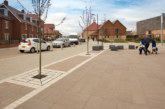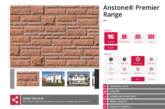
Rob Woolston, Director at multi-disciplinary design practice rg+p discusses the hidden conflicts faced when pairing the aspirations of urban design with the requirements of the local authority.
Good residential development should create a sense of place, whether it’s revitalising a brownfield, inner city site or creating a new community in a greenfield setting. One of the many challenges for designers and developers in achieving this is the lack of consistency between Local Planning Authorities (LPAs) in their adopted policies that apply to ‘design’ and ‘highways’.
Some of the most common variations between LPAs include back-to-back and back-to-side interface distances, driveway sizes, garden size and acceptable parking solutions. Whilst on the face of it these can seem like relatively minor variations, they can reduce the efficiency of standard perimeter block / plotting approaches and add up to lost coverage across larger sites.
Another example arises when designing public realm. The practicalities of delivering high quality streetscapes, the nature of which may be prescribed in site specific guidance such as design codes, often runs into problems over the willingness of the highway authority to adopt verges and street trees and the related commuted sums for trees; often running into thousands of pounds in some scenarios. Solutions can include locating trees in private gardens to the front of dwellings although this can in turn require upgraded foundations and there is no guarantee that they will be retained in the long term. The use of management companies (‘Mancos’) is now being promoted by some LPAs in order to address this although the cost will be passed on to homeowners, resulting in some cases for street trees to be removed altogether.
Home zones
The continuing use of shared surface streets (home zones) within residential development has been called into question recently following advice from the Department of Transport. These types of streets are popular with residents and developers, and over the last few years have been a key component of many an urban designers’ street hierarchy. Again, some LPAs are continuing to allow them with certain design criteria whilst others are against them, and this is a good example of the subjectivity of many design standards.
Density becomes another constraint. Whilst it is reasonable to expect authorities to prescribe the property mix when it comes to affordable homes, so demand can be satisfied, should the same apply for private development? Surely the local market should dictate? This makes it problematic for us as designers as it affects our ability to plot efficient layouts which in turn can lead to issues over viability.
Design codes
The good news is that following the recent NPPF guidance, there is a new emphasis on authorities to have completed viability testing before instilling new design principles; meaning a potentially positive conclusion of fewer conflicts as the design codes should now be based on the commercial reality of delivering a scheme.
Whilst these little idiosyncrasies do present conflict, by no means do they exist in every district and we’re regularly working with LPAs who share our hopes for high quality, sustainable developments. Through early engagement upfront and a willingness from both sides to explore the options, there is room for negotiation so that our aspirations remain undiluted and collaboratively, we create a lasting legacy of good design and a positive sense of place in our communities.








